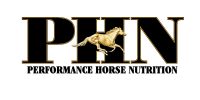THE USE IN HORSES AND PONIES OF
GRAZING MUZZLES
June 2014

Written by Performance Horse Nutrition
The horse has evolved as a grazing animal; pasture plays a pivotal role in equine nutrition. Reported intakes of fresh pasture by horses can range from 1.5 to 5.2 % of body weight/day. With such a large intake of pasture possible, can horses over consume? What components of pasture grass can cause problems if taken in at excessive levels?
Pasture has been implicated in the onset of several metabolic disorders in horses. During photosynthesis, green plants ‘fix’ atmospheric carbon dioxide in the presence of light, resulting in the production of simple sugars. When sugars are produced in excess of the energy requirement of the plant for growth and development, they are converted into storage, or ‘reserve’ carbohydrates. These carbohydrates make up the nonstructural carbohydrate (NSC) fraction of the plant. These non-structural carbohydrates follow a seasonal pattern with highest values in spring compared to summer and winter, and intermediate values in the autumn. The over consumption of nonstructural carbohydrates by grazing horses have been implicated with disorders including insulin resistance and laminitis.
In addition to sugar and starch (NSC) causing metabolic issues, the sheer over consumption of pasture grass can cause obesity in horses. Obesity can result in further problems with insulin sensitivity as body fat mass increases. All of these over-weight conditions result in a cascade of problems that at the very least leave your horse fat and intolerant of exercise to far more severe conditions such as insulin insensitivity and laminitis. It has been reported that excessive pasture intake accounts for nearly 50% of all reported cases of laminitis. Obesity therefore must be corrected.
The first step in any weight reduction program is calorie control. Elimination of all grain from the diet is a logical step for overweight horses. A low intake vitamin and mineral supplement pellet should be added to the diet as a means of supplying key nutrients to the horse without excess calories. Another key to success is limiting or eliminating access to pasture. Pasture grazing represents an unregulated source of calories that cannot be easily quantified. It is therefore necessary to limit pasture access until weight loss has been achieved.
Physical prevention of excessive pasture intakes by horses can be achieved using grazing muzzles. Grazing muzzles are commonly recommended for controlling grass intake in overweight and laminitis prone horses and ponies. The use of grazing muzzles reduces bite size and restricts intakes to the tops of leaves, where the concentrations of sugar (NSC) tend to be lowest. Grazing muzzles may be favored by owners over other methods of intake restriction that limit animals to very short turnout times or confinement to stables or small bare paddocks. Grazing muzzles enable the animal to graze larger areas and for longer periods and owners do not have to implement severe changes to their facilities. In addition, a horse that is allowed to graze with a muzzle continues to move around in the pasture and get at least some exercise.
Not all horse owners need to be concerned with pasture intake restriction. For the majority of horses, total restriction is not always a viable or desirable option for financial, welfare, and health reasons. It may also not be necessary for those animals that are not predisposed to a metabolic disorder. The first step in determining ifyour horse is a candidate for a grazing muzzle is to determine the laminitis risk.
There may be breed, age, and sex effects in the incidence of laminitis. Certainly it is generally accepted that ponies are more commonly affected by laminitis than horses. If you own a pony, buy a grazing muzzle you will eventually need to use it. Thoroughbreds and Standardbreds have a lower risk of developing laminitis but this is probably due to activity level rather than breed. Ponies and horses that have been previously affected with laminitis or are affected with certain other diseases (e.g. Cushings disease or insulin resistance) are at higher risk of developing laminitis. For those animals identified as being at high risk of developing laminitis a grazing muzzle may be necessary. A less radical solution compared to using a grazing muzzle would be to restrict pasture access by controlling the amount of time they graze. Simply restrict the grazing opportunity to two hours or less per day. Further, grazing can be restricted during times of high risk such as during the spring and fall.
The pasture is the most dynamic and most dangerous component of the diet if the horse has previously suffered from laminitis. If an affected horse is returned to pasture, use of a grazing muzzle is recommended to limit grass intake. Grazing muzzles can be worn every day or only during months when the pasture grass is more abundant and contains higher concentrations of non-structural carbohydrates. Turnout on pasture should be avoided when the pasture grass is growing rapidly in the spring after the weather turns warmer or during the summer after heavy rain. Temperate pasture grasses also accumulate sugar when they are stressed by drought or the onset of winter. When a horse is returned to pasture after being confined to a stall for several days, reintroduction should occur gradually, with no more than 1 hour of grazing at a time for the first 2 weeks.
While grazing muzzles are recommended to reduce pasture intake there is limited data on their effectiveness. A recent study utilizing ponies aimed to determine the extent of intake restriction imposed by grazing muzzles. Ponies fitted with grazing muzzles on average ate approximately 83% less forage than those without grazing muzzles. Ponies with muzzles were only able to consume 0.14 % of their body weight during 3 hours. Grazing muzzles appear to be an effective means of restricting pasture intake by ponies.
Management strategies for using grazing muzzles
- The muzzle should be attached to a breakaway halter and fit should be checked often. The extra weight of the muzzle adds more pressure to the bridge of the nose than usual, and pressure sores can sometimes develop. Encasing the noseband in fleece may provide relief.
- Introduce the muzzle slowly by introducing the muzzle for short periods in the stable and rewarding your horse with a treat through the hole in the muzzle each time you put it on and take it off. As you progress outside with your horse wearing the muzzle feed grass through the hole so your horse gets the idea that he can still eat. Initially leave the muzzle on for short periods gradually building up the time your horse grazes with the muzzle on.
- Make sure that your horse is comfortable drinking with the grazing muzzle on. Try this in the stable first by offering a bucket of water directly to your horse in hand and you will find they are quick to investigate, especially if you have been offering treats through the hole in the muzzle!
- Make sure the muzzle fits correctly as this will help prevent your horse removing it.
- Don’t leave the muzzle on all day.
- When your horse is not wearing the grazing muzzle bring them in off the grass as they are able to graze freely and may even try to compensate for the restriction earlier in the day.
- Beware of herd dominance and make sure the horse wearing the muzzle is not being bitten by others in the group
-Dr. Stephen Duren & Dr. Tania Cubitt

